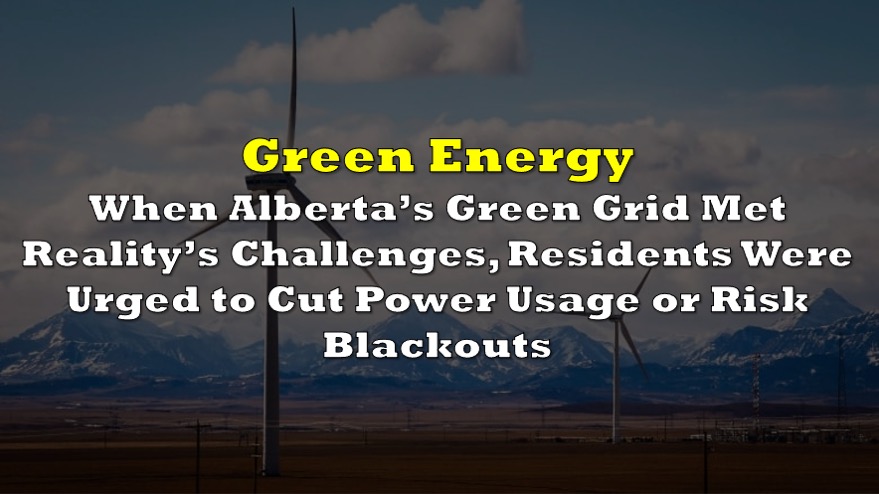It appears that Mother Nature decided to give the Alberta Electric System Operator (AESO) a good run for its money.
On Monday, Albertans received a “grid alert,” cautioning everyone to curtail their power usage or risk a blackout. Why? A trifecta of hot weather, a BC outage hampering power imports, and the wind— apparently taking a day off, decided to turn wind turbines into expensive net-zero lawn ornaments.
Due to a combination of hot weather, a BC outage that affects intertie capability to import, and low wind generation, the AESO has declared a Grid Alert. Find information on Grid Alerts here https://t.co/zN7VTcpkqV pic.twitter.com/0dsBB6XoI7
— AESO (@theAESO) August 28, 2023
Alberta Premier Danielle Smith urgently took to social media, emphasizing the strain on their power infrastructure, a stark contrast to the blaring heat outside. With the interconnection to BC compromised and wind farms barely producing, Alberta was leaning heavily on natural gas and solar. Smith’s message was clear: Alberta needed a more robust power generation strategy, one that could withstand such vulnerabilities.
The Alberta Electric System Operator has issued a Level 3 power alert for Alberta. Our system is currently under intense strain due to the heat combined with very little wind to generate power. We are relying almost entirely on natural gas supplemented with solar to power our… pic.twitter.com/RkUrtaoZ9D
— Danielle Smith (@ABDanielleSmith) August 28, 2023
AESO, in a bid to manage the crisis, requested residents avoid using power-hungry appliances such as dishwashers at least until the evening.
I had plugged my car in (I had set it to about 5.5kW) but stopped it as soon as I saw the alert.
— Arden Shibley 🏳️🌈 (@yelbihs) August 28, 2023
The energy statistics during this period painted a vivid picture. Wind energy, usually a formidable contributor, was only managing around 1% of its installed capacity. Solar power, though performing well earlier, was about to hit its daily decline as evening approached. And the electricity flowing between British Columbia and Alberta was at a mere trickle— just 3 megawatts.
This crisis wasn’t an isolated event. Just a day before, Texas had faced a similar grid stress due to a mix of high temperatures and dwindling renewable energy sources.
(1/2) TXANS Update—August 27, 2023: ERCOT has issued a Conservation Appeal for today, Aug. 27, from 4 – 9 p.m. CT. Operating reserves are expected to be low in the afternoon and evening due to low wind and potential low solar generation and high demand. pic.twitter.com/OTvarcrF8c
— ERCOT (@ERCOT_ISO) August 27, 2023
Information for this briefing was found via the sources mentioned within the article. The author has no securities or affiliations related to this organization. Not a recommendation to buy or sell. Always do additional research and consult a professional before purchasing a security. The author holds no licenses.















